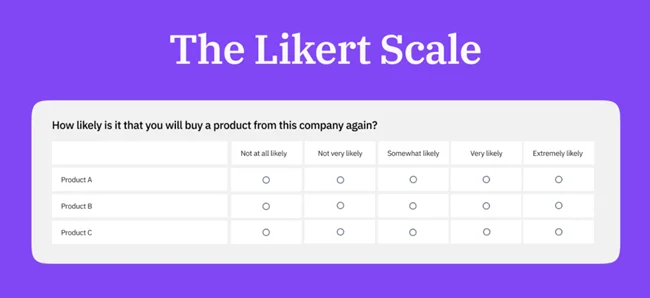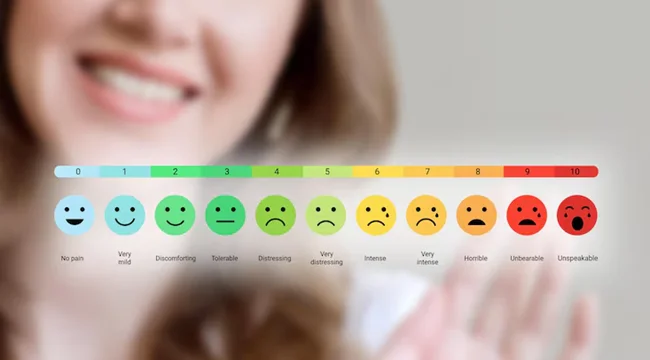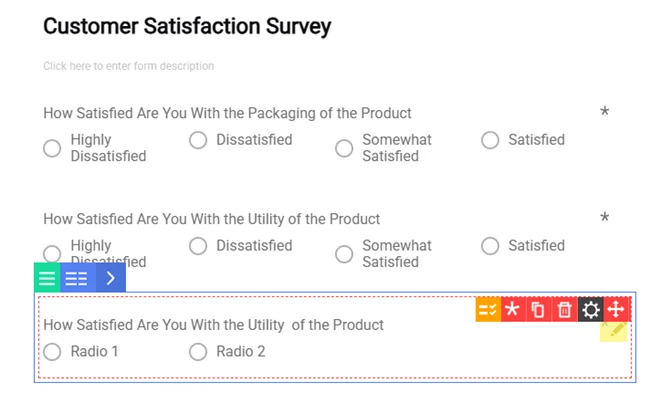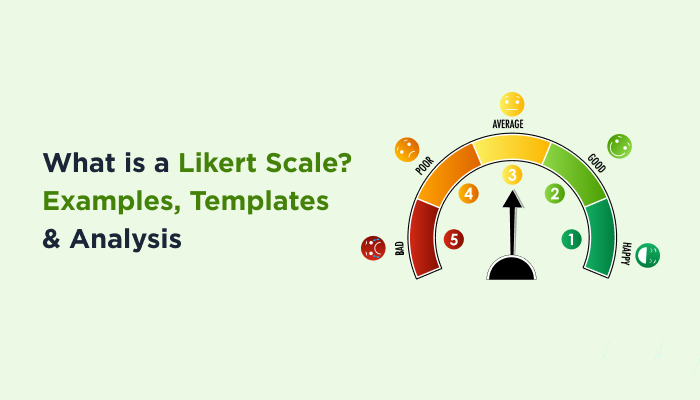What Is a Likert Scale? Examples, Templates & Analysis (2025 Guide)
When you’re conducting surveys, one of the efficient ways of getting responses is by creating an advanced form. However, how to get subjective opinions in a measurable way? The answer is by using the Likert scale!
Using a Likert scale is a proven method used in customer surveys, product feedback, social surveys, psychological tests, and more. It efficiently helps measure people’s attitudes, perceptions, and behaviors. This scaled form response provides you with a powerful way to gather reliable feedback.
If you have no idea about the Likert scale or want to understand it in more depth, this article is for you. From what is Likert scale to its importance, real-world examples, question templates, analysis tips, etc., you will get it all here.
So, are you ready to dive in?

A Likert scale analysis helps you measure respondents’ opinions, feelings, and attitudes about different topics. Thus, instead of asking basic Yes/No questions, this method allows respondents to mark their level of agreement.
The following is an example of a Likert Scale for getting a better idea.
Strongly Disagree – Disagree – Neutral – Agree – Strongly Agree
Herein, a visitor does not need to give a clear-cut blank and white answer. It helps you get detailed insights and the level of satisfaction of users. You can know what they’re really thinking. The Likert Scale was introduced in the 1930s by Rensis Likert for a simple way to quantify attitudes in a research survey.
If you want a simple version to start with, this is your answer. It is pretty easy to use and quick to answer. However, if you want in-depth detail, this might give you a limited viewpoint.
This is perfect for short surveys wherein detailed feedback is not that essential.
Here in this version, the neutral middle option is removed. Thus, a respondent has to answer in one way or the other. It is perfect when you want a clear, decisive opinion instead of people just hitting neutral.
Use a 4 point Likert Survey for political polls, performance reviews or situations wherein neutrality is not possible.

Options: Strongly Disagree – Disagree – Neutral – Agree – Strongly Agree
This is the most common and widely used format of the Likert scale. It is simple yet detailed for getting proper feedback. These surveys are perfect for all sorts of forms across industries.
This is an even-numbered version with more in-depth options. However, this too removes the factor of neutrality to capture the respondent’s decision more precisely.
In the 7 point Likert Scale, you get a wider flexibility with the option for neutrality as well. If you are doing a detailed academic or industry research, this is your exquisite weapon. This would help you with data analysis strongly and positively.

Options: A wide spectrum from 1 to 10 (e.g., 1 = Completely Disagree, 10 = Completely Agree)
Using a 10 point scale, you can add in very detailed options or allow respondents to answer on a scale of 1-10. Though detailed, it can overwhelm customers. More choices, more confusion. Thus, use this tool only when extremely necessary. It is perfect for health and wellness industry.
Good: “I found the onboarding process helpful.”
Avoid: “The onboarding and support process was okay, I guess.”
Good: “The customer support team was responsive.”
Avoid: “Support was fine, I guess, but sometimes not great.”
Good: “The course material was well-organized.”
Avoid: “The course material and instructor were helpful.”
Example:
Avoid: “Our amazing support team helped you, right?”
Better: “The support team resolved my issue effectively.”
With these tips, you can easily create a Likert scale that is rich in insights and easy to answer. Thus, you can make better decisions based on proper feedback.
Step-1: Install and Activate ARForms on your Website (Free Download or Purchase)
Step-2: Click on ‘Add New Form’ from the left-side panel. Add Form Title and Description as per your requirement.
Step-3: Once you’ve made your questions, use the Radio Button fields. Add 3-4-5-6-7 radio buttons and rename them as per your requirements. Here in this example, I have taken satisfaction levels for the Likert Scale instead of the Agree Disagree scale. You just have to click on the Manage Option of the Radio Button field to add them.

As you can see in the image above, you can easily create and publish a form with Likert Scale fields using ARForms and Radio Buttons.
If you’re using ARForms Pro, you can also employ smileys along with your Likert Scale so that customers get a visual representation and can choose even more easily.

You need to consider certain things like the right number of scale options, effective statements, result analysis, etc. This guide gives you everything you need to start building a form with Likert Scale options. Utilize ARForms for creating an advanced form by adding Likert scale fields. Furthermore, gather your data via a Google Sheets addon or the built-in data analytics tool of ARForms.
Start building smarter, faster surveys and gather better feedback from your respondents.
I am satisfied with the product quality.
Options: Dissatisfied, Somewhat Dissatisfied, Neutral, Somewhat Satisfied, Satisfied
Read this also:
Using a Likert scale is a proven method used in customer surveys, product feedback, social surveys, psychological tests, and more. It efficiently helps measure people’s attitudes, perceptions, and behaviors. This scaled form response provides you with a powerful way to gather reliable feedback.
If you have no idea about the Likert scale or want to understand it in more depth, this article is for you. From what is Likert scale to its importance, real-world examples, question templates, analysis tips, etc., you will get it all here.
So, are you ready to dive in?
What Is a Likert Scale?

A Likert scale analysis helps you measure respondents’ opinions, feelings, and attitudes about different topics. Thus, instead of asking basic Yes/No questions, this method allows respondents to mark their level of agreement.
The following is an example of a Likert Scale for getting a better idea.
Strongly Disagree – Disagree – Neutral – Agree – Strongly Agree
Herein, a visitor does not need to give a clear-cut blank and white answer. It helps you get detailed insights and the level of satisfaction of users. You can know what they’re really thinking. The Likert Scale was introduced in the 1930s by Rensis Likert for a simple way to quantify attitudes in a research survey.
What Makes It a “Likert Type” Scale?
A question format that has certain levels of agreement or disagreement on a symmetric scale makes it a Likert-type question. Be it a 3-point, 5-point, or 7-point scale, it is still called a Likert scale.Why Use a Likert Scale?
Now, what’s the benefit of using a Likert Scale? Why do you see them on mostly all sorts of forms, from customer satisfaction ones to employee feedback? Because this method is pretty simple and super effective.Easy for Respondents
Likert scales are easy to understand. They can be answered quickly without having to write any long answers. A user can easily choose the option that they feel the best match.Delivers Richer Data
Going from a yes/no question to an agree disagree scale widens the layer of insight you get from the respondents. Thus, instead of scratching just the surface, you get to know how strongly someone feels.Perfect for Measuring Attitudes
Using Likert type scale, you can quantify the attitudes of the respondents. It helps you measure qualitative aspects like customer satisfaction, employee engagement, public opinion, etc. Thus, it’s a perfect scale for qualitative research.Works Great in Digital Forms
With online form builders like ARForms, you can easily create a Likert scale question. You can add structured rating options, use emojis, and collect detailed feedback.Ideal for Surveys of All Types
Be it academic research or a product review, a Likert type scale can be effectively utilized for all scenarios.- Customer satisfaction surveys
- Employee feedback forms
- Market research
- Product/service evaluations
Types of Likert Scales
Depending on the depth or the amount of details you want, you can leverage different types of Likert scales. They can be broken down into the following formats.1. 3 Point Likert Scale
Options: Agree – Neutral – DisagreeIf you want a simple version to start with, this is your answer. It is pretty easy to use and quick to answer. However, if you want in-depth detail, this might give you a limited viewpoint.
This is perfect for short surveys wherein detailed feedback is not that essential.
2. 4 Point Likert Scale (Forced Choice)
Options: Strongly Agree – Agree – Disagree – Strongly DisagreeHere in this version, the neutral middle option is removed. Thus, a respondent has to answer in one way or the other. It is perfect when you want a clear, decisive opinion instead of people just hitting neutral.
Use a 4 point Likert Survey for political polls, performance reviews or situations wherein neutrality is not possible.
3. 5 Point Likert Scale

Options: Strongly Disagree – Disagree – Neutral – Agree – Strongly Agree
This is the most common and widely used format of the Likert scale. It is simple yet detailed for getting proper feedback. These surveys are perfect for all sorts of forms across industries.
4. 6 Point Likert Scale
Options: Strongly Disagree – Disagree – Slightly Disagree – Slightly Agree – Agree – Strongly AgreeThis is an even-numbered version with more in-depth options. However, this too removes the factor of neutrality to capture the respondent’s decision more precisely.
5. 7 Point Likert Scale
Options: Strongly Disagree – Disagree – Somewhat Disagree – Neutral – Somewhat Agree – Agree – Strongly AgreeIn the 7 point Likert Scale, you get a wider flexibility with the option for neutrality as well. If you are doing a detailed academic or industry research, this is your exquisite weapon. This would help you with data analysis strongly and positively.
6. 10-Point Likert Scale (Extended)

Options: A wide spectrum from 1 to 10 (e.g., 1 = Completely Disagree, 10 = Completely Agree)
Using a 10 point scale, you can add in very detailed options or allow respondents to answer on a scale of 1-10. Though detailed, it can overwhelm customers. More choices, more confusion. Thus, use this tool only when extremely necessary. It is perfect for health and wellness industry.
Choosing the Right Likert Scale
The best Likert scale for your form depends on:- The type of data you need.
- How detailed do you want the responses to be?
- How much time is your audience willing to spend?
Likert Scale Examples for Your Surveys
Now that you have a brief idea about the benefits and utility of a Likert scale, let’s look at the top Likert scale examples. These examples will help you create better and clearer questions for the survey.Common Question Themes
Here are a few popular categories where Likert scale questions shine:- Customer Satisfaction
- Product or Service Feedback
- Employee Engagement
- Event or Training Evaluation
- Education and Learning Experience
| Statement | Strongly Disagree | Disagree | Neutral | Agree | Strongly Agree |
| I am satisfied with the overall quality of the product. | ⭘ | ⭘ | ⭘ | ⭘ | ⭘ |
| The website was easy to navigate. | ⭘ | ⭘ | ⭘ | ⭘ | ⭘ |
| I feel motivated and valued at my workplace. | ⭘ | ⭘ | ⭘ | ⭘ | ⭘ |
| The instructor explained the material clearly. | ⭘ | ⭘ | ⭘ | ⭘ | ⭘ |
| I would recommend this service to others. | ⭘ | ⭘ | ⭘ | ⭘ | ⭘ |
Tip: Use Clear, Focused Statements
The best way to get accurate responses from a Likert Scale survey is by using very clear and to-the-point questions. Avoid using vague language. Ensure that your statements are direct and specific. Furthermore, one question should only ask about one thing so that the respondents are not confused.Good: “I found the onboarding process helpful.”
Avoid: “The onboarding and support process was okay, I guess.”
Best Practices for Writing Likert Scale Questions
You must design Likert scale questions in a way that it doesn’t confuse your audience and gets the right answers. That’s why we have come with the best practices along with examples of Likert scale questions.1. Be Clear and Specific
Your statements should be simple and easy to understand. Avoid jargon, vague words, or double meanings.Good: “The customer support team was responsive.”
Avoid: “Support was fine, I guess, but sometimes not great.”
2. Stick to One Idea Per Statement
Each question should ask about one thing only. Combining two concepts can confuse respondents and make the data harder to interpret.Good: “The course material was well-organized.”
Avoid: “The course material and instructor were helpful.”
3. Keep the Scale Balanced
Make sure you have an equal number of positive and negative response options. This helps reduce bias and gives a true picture of sentiment.Example:
- Strongly Disagree
- Disagree
- Neutral
- Agree
- Strongly Agree
4. Use a Neutral Option Wisely
Decide whether you want to give respondents the option to stay neutral. Including a middle option (like “Neutral” or “Neither Agree nor Disagree”) can reduce forced responses, but leaving it out can encourage clearer choices.5. Use Consistent Wording and Scale Order
Keep your scale points consistent across all questions. Flipping between different scales (e.g., from “Agree/Disagree” to “Satisfied/Unsatisfied”) can confuse users.6. Avoid Leading or Biased Language
Don’t write statements that push respondents toward a particular answer.Avoid: “Our amazing support team helped you, right?”
Better: “The support team resolved my issue effectively.”
7. Test Before You Launch
Run a quick pilot test or ask a few people to review your questions. Their feedback can help you fine-tune wording, clarity, and scale effectiveness.With these tips, you can easily create a Likert scale that is rich in insights and easy to answer. Thus, you can make better decisions based on proper feedback.
Create a Likert Scale Survey with ARForms
It is very easy to create a Likert Scale survey for your business using ARForms – WordPress Forms.Step-1: Install and Activate ARForms on your Website (Free Download or Purchase)
Step-2: Click on ‘Add New Form’ from the left-side panel. Add Form Title and Description as per your requirement.
Step-3: Once you’ve made your questions, use the Radio Button fields. Add 3-4-5-6-7 radio buttons and rename them as per your requirements. Here in this example, I have taken satisfaction levels for the Likert Scale instead of the Agree Disagree scale. You just have to click on the Manage Option of the Radio Button field to add them.

As you can see in the image above, you can easily create and publish a form with Likert Scale fields using ARForms and Radio Buttons.
If you’re using ARForms Pro, you can also employ smileys along with your Likert Scale so that customers get a visual representation and can choose even more easily.

Wrapping Up
Likert Scales speak a universal language for everyone. Be it customers, students, employees, or website users. This provides the best way to measure audience attitudes, satisfaction, and opinions. It provides a way to measure subjective opinions and feelings.You need to consider certain things like the right number of scale options, effective statements, result analysis, etc. This guide gives you everything you need to start building a form with Likert Scale options. Utilize ARForms for creating an advanced form by adding Likert scale fields. Furthermore, gather your data via a Google Sheets addon or the built-in data analytics tool of ARForms.
Start building smarter, faster surveys and gather better feedback from your respondents.
FAQs
1. What is a Likert scale?
A Likert Scale is a rating scale that is helpful in measuring attitudes and opinions of the respondents. It indicates their level of satisfaction, agreement, or likelihood with the statement or question that you provide.2. What is an example of a Likert scale question?
Likert Scale example, for instance,I am satisfied with the product quality.
Options: Dissatisfied, Somewhat Dissatisfied, Neutral, Somewhat Satisfied, Satisfied
3. What is a 5-point Likert scale?
A 5 point Likert Scale includes five options for user responses. It can be Strongly Disagree, Disagree, Neutral, Agree, Strongly Agree. It is one of the most common formats used in varied surveys.4. How do we analyze Likert Scale Data?
You can analyze Likert Scale data by assigning specific numeric values to each response. Thereafter, you can calculate the mean, median, or frequency distribution of the answers. These can then be presented in a graphical format for visual data presentation.Read this also:



